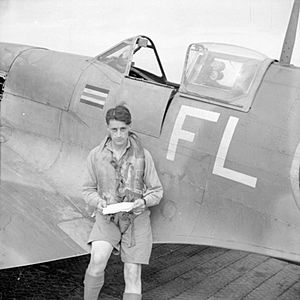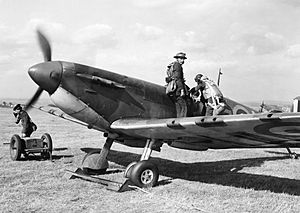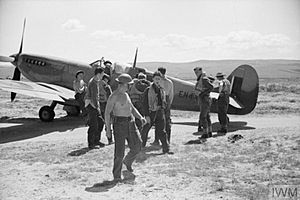Colin Falkland Gray facts for kids
Quick facts for kids
Colin Falkland Gray
|
|
|---|---|

Gray, pictured during his time in command of No. 81 Squadron
|
|
| Born | 9 November 1914 Christchurch, New Zealand |
| Died | 1 August 1995 (aged 80) Porirua, New Zealand |
| Allegiance | United Kingdom |
| Service/ |
Royal Air Force |
| Years of service | 1939–1961 |
| Rank | Group Captain |
| Commands held | RAF Church Fenton (1954–56) Lympne Wing (1944) No. 322 Wing (1943) No. 81 Squadron (1943) No. 64 Squadron (1942) No. 616 Squadron (1941–42) |
| Battles/wars | Second World War Malayan Emergency |
| Awards | Distinguished Service Order Distinguished Flying Cross & Two Bars |
| Other work | Personnel Director at Unilever |
Group Captain Colin Falkland Gray, DSO, DFC & Two Bars (born November 9, 1914 – died August 1, 1995) was a brave pilot in the Royal Air Force (RAF). He was the best New Zealand fighter pilot during the Second World War.
Colin Gray was born in Christchurch, New Zealand. He joined the RAF in 1939, even though he had been turned down twice for health reasons. He flew with No. 54 Squadron during the Battle of France. His twin brother, who was also an RAF pilot, sadly died in a flying accident around this time.
Gray flew many missions during the Battle of Britain. By September 1940, he had shot down 14 enemy planes. He was given the Distinguished Flying Cross (DFC) for his bravery. After a short time training new pilots, he returned to combat in 1941.
He later led No. 616 Squadron and earned another award, a Bar to his DFC. He then went to the Mediterranean area to lead No. 64 Squadron. By 1943, he was a wing commander. He flew many missions in North Africa and Italy. By the end of 1943, he had destroyed at least 13 more enemy planes. He also received the Distinguished Service Order.
Gray returned to Europe in 1944. In September, he led a wing that supported airborne troops during the Battle of Arnhem. By the end of the war, he had officially shot down 27 enemy aircraft. After the war, he continued to serve in the RAF. He retired in 1961 and moved back to New Zealand. He worked for Unilever and passed away in 1995 at age 80.
Contents
Early Life and Joining the RAF
Colin Falkland Gray and his twin brother Ken were born in Christchurch, New Zealand, on November 9, 1914. Their father, Robert Leonard Gray, was an electrical engineer. Colin went to several schools, including Christ's College and Napier Boys' High School. After school, he worked as a clerk in Napier starting in 1933.
In April 1937, Colin and Ken tried to join the Royal Air Force (RAF). Ken was accepted, but Colin was not because he was sick with the flu. Colin tried again to join the Civilian Reserve of Pilots but was rejected again for health reasons. Doctors told him he might never be fit enough for the RAF. He had a bone infection in his leg and often got eye infections.
But Colin didn't give up! He worked as a sheep herder to get fitter. In September 1938, he passed his medical exam and was finally accepted into the RAF. He chose to train in the United Kingdom. His flight training began in early 1939. He earned his wings in July and became a pilot officer in October 1939.
Colin Gray in the Second World War
When the Second World War began, Gray joined No. 54 Squadron in November 1939. This squadron flew Supermarine Spitfire planes from Hornchurch. Another pilot there was Alan Deere, who also became a famous New Zealand pilot. In the early war months, the squadron trained and flew patrols over the North Sea.
On May 1, 1940, Colin's brother Ken, a bomber pilot, was flying to visit Colin. Sadly, Ken's plane crashed into a hill, and he died. This deeply affected Colin.
Battle of France Missions
As the war in France got worse, No. 54 Squadron started patrolling over Calais and Dunkirk. Colin flew his first mission there on May 16. He first met German planes, called the Luftwaffe, on May 24. He fought two Messerschmitt Bf 109 fighters. He thought he hit both of them.
The next day, May 25, he shot down his first confirmed enemy plane, a Bf 109. He was protecting Fairey Swordfish planes bombing Gravelines. His Spitfire was hit many times and badly damaged. The plane's controls, guns, and speed indicator stopped working. But Gray managed to land safely at Hornchurch.
After many missions over Dunkirk, the squadron needed a rest. They went to Catterick in Yorkshire. They returned to Hornchurch on June 4. They spent most of June flying patrols over France and Belgium. On July 3, Gray fought a Dornier Do 215 bomber and likely shot it down.
Fighting in the Battle of Britain
The Battle of Britain began on July 10, 1940. German planes attacked targets in England and ships. Their goal was to destroy the RAF so they could invade Britain. Gray's squadron was part of No. 11 Group, which defended southeast England. They were very busy in the battle.
On July 13, Gray shot down a Bf 109 near Calais. A week later, his squadron met German bombers with 30 Bf 109 escorts. Gray shot down two Bf 109s. He saw one pilot parachute into the Channel. Gray radioed the pilot's location, but the pilot did not survive. The next day, July 25, he likely shot down another Bf 109. This plane was protecting Junkers Ju 87 dive bombers attacking ships near Dover.
On July 26, No. 54 Squadron went back to Catterick for a rest. They had flown more missions than any other squadron in their group. Gray had flown 68 missions in July.
Gray's squadron returned to the Battle of Britain on August 8. They were based at Hornchurch again. He quickly added to his victories. On August 12, he shot down two Bf 109s. He did it again on August 16, destroying two more Bf 109s over Dover. On August 18, he helped destroy a Messerschmitt Bf 110 and damaged a Dornier Do 17. Later that day, he shot down another Bf 110 over Clacton.
On August 24, he shot down another Bf 110 near Dover. He ran out of bullets, but the enemy plane was badly damaged and crashed into the sea. He destroyed a Bf 109 on August 25. Two days later, he was awarded the Distinguished Flying Cross (DFC). The award said he had shot down four Bf 109s and likely four more. It praised his courage and determination.
On August 28, Gray damaged two Bf 109s and a Do 17. On the last day of August, he shot down another Bf 109 near Maidstone. The next day, he fought three Heinkel He 111 bombers. He set two engines of one He 111 on fire. His own plane was damaged, but he landed safely. Later that day, his engine was damaged after fighting Bf 109s. He had to make an emergency landing.
On September 2, Gray flew five missions. He shot down a Bf 109, though his plane was damaged. He then destroyed a Bf 110 that was attacking Hornchurch. The next day, he helped destroy a Bf 110. Later, he shot down another Bf 109. This was his last fight in the battle. His squadron moved north to rest. Gray was very tired. He had flown over 60 missions in August. By this time, he had destroyed 14 and a half enemy planes. He was one of only four pilots who had been with the squadron since May.
At Catterick, No. 54 Squadron became a training unit. Gray taught new pilots how to fight in the air. He was promoted to flying officer on October 23. Two months later, he joined No. 43 Squadron, which flew Hawker Hurricanes. He liked the Hurricane but preferred the Spitfire. He continued training pilots until January 1941. Then he returned to No. 54 Squadron as a flight commander.
Channel Front Operations
By late February, No. 54 Squadron was back at Hornchurch. They flew missions against targets in France. In mid-1941, Gray joined No. 1 Squadron, which flew Hurricanes. He was a flight commander. On one mission, they escorted Westland Lysander planes doing air-sea rescues. They met a Heinkel He 59 seaplane with Bf 109 escorts. Gray and another pilot shot down the He 59.
In July, No. 1 Squadron moved to Tangmere. They protected Allied ships and trained for night interceptions. Gray was promoted to flight lieutenant in August 1941. That month, he shot down a Bf 109 over Le Havre. In September, he received a Bar to his DFC. This meant he had earned the DFC again. The award said he had destroyed eight more enemy planes, bringing his total to 17. It also said he had probably destroyed nine more.
At the end of September, Gray became an acting squadron leader. He was put in charge of No. 616 Squadron at Westhampnett. This squadron flew Spitfire Vbs on daylight missions into France. They later moved north to patrol the east coast of England. In early 1942, Gray left command to work at No. 9 Group, advising on fighter tactics.
Gray returned to combat in September 1942. He spent a short time with No. 485 Squadron, which had many New Zealand pilots. Then he took command of No. 64 Squadron. This squadron flew the newer Spitfire Mk IX over the English Channel and France. They also escorted Boeing B-17 Flying Fortress bombers from the United States.
Missions in the Mediterranean
At the end of 1942, Gray was sent to the Mediterranean area. In January 1943, he went to Gibraltar to take command of No. 81 Squadron. The squadron's pilots were there to pick up the first Spitfire Mk IXs for that region. No. 81 Squadron flew across the Mediterranean to Algeria later that month.
Gray soon met the enemy. On January 31, he led Spitfires to stop a raid on Cap Negro. Three Bf 109s were shot down. Gray later said he destroyed one Bf 109 but gave the credit to his wingman. On February 22, he probably destroyed a Bf 109. A few days later, he damaged another. On March 2, he shared in probably destroying a Bf 109.
No. 81 Squadron moved to Souk-el-Khemis Airfield in mid-March. A week later, Gray shot down a Macchi C.202 fighter. Two days later, he shot down a Bf 109. At the end of March, he shot down another Bf 109. The pilot parachuted out. It was thought to be a famous German ace, but it was another pilot with the same last name.
Early the next month, Gray's Spitfire engine started having problems. He was returning to the airfield when he saw eight Focke Wulf Fw 190 fighter-bombers attacking it. Despite his engine trouble, he chased them but couldn't catch them. He turned back and then found and shot down a Bf 109.
On April 18, Gray probably shot down a Bf 109 over Tunis. Two days later, he shared in destroying another Bf 109. He destroyed a second Bf 109 over Tunis later that day. Two more Bf 109s were destroyed later in April. The war in North Africa ended the next month. For his leadership in North Africa, Gray was awarded the Distinguished Service Order (DSO). The award said he was a "first class fighter" and had destroyed five enemy aircraft, bringing his total to at least 21.
Gray was promoted to acting wing commander on June 1. He took command of No. 322 Wing at Takali, on the island of Malta. The wing flew patrols and escorted bombers over Italy. They only sometimes met German planes. Gray shot down a Bf 109 on June 14 and a C.202 a few days later.
On July 1, the wing supported the Allied invasion of Sicily. That day, several Bf 109s attacked the wing, but Gray shot down one. No. 322 Wing moved to Lentini, Sicily, in late July. On July 25, 1943, Gray led 33 Spitfires to intercept German supply planes near Milazzo. They found a large group of Junkers Ju 52 transport planes. The Spitfires surprised the escorting Bf 109s and attacked the Ju 52s. At least 20 transports were destroyed, many carrying fuel. Gray shot down two of them, his last victories of the war. Four Bf 109s were also destroyed.
Back to Europe
Gray' was made a permanent squadron leader on September 1, 1943. Soon after, he left No. 322 Wing and went to Cairo for special duties. In October, he returned to England. He then commanded No. 2 Combat Training Wing in Scotland. On November 9, King George VI presented him with his DSO at Buckingham Palace. Alan Deere, his friend from No. 54 Squadron, was also there. At the same time, Gray was awarded a second Bar to his DFC. He only found out when he read it in a newspaper!

At the end of 1943, Gray took another training role. He stayed there until June 1944. Then he became commander of the Spitfire Wing at the Fighter Leader's School. A few months later, he was put in charge of the Lympne Wing. This wing flew missions into France and the Netherlands. In September, his wing supported the airborne operations during the Battle of Arnhem. The next month, he returned to Buckingham Palace to receive his second DFC Bar.
In January 1945, Gray attended a course for senior commanders. Then he took command of the RAF station at Skeabrae in the Orkney Islands. The Spitfire squadron there protected the Royal Navy base at Scapa Flow. In April, Gray's position in the RAF became permanent, and he held the rank of squadron leader.
By the end of the war, Colin Gray had officially destroyed 27 enemy aircraft. He also shared in destroying one more, probably destroyed seven, and damaged 12. He was the top New Zealand fighter pilot of the Second World War. He had flown over 600 hours in combat.
After the War
Gray returned to New Zealand from July 1945 to March 1946. He spent most of this time on leave. He also gave talks to units of the Air Training Corps. He returned to England in March 1946. He was promoted to acting wing commander, then to permanent wing commander the next year. He worked at the Air Ministry in different roles.
In January 1950, Gray went to Washington, D.C. He worked as an air liaison officer. He helped manage the exchange program between the RAF and the United States Air Force. He returned to the United Kingdom in September 1952. After a short time in an administrative role, he commanded Church Fenton in Yorkshire from March 1954 to April 1956. During this time, he was promoted to group captain.
He then went to Singapore to work at the headquarters of the Far East Air Force. During the Malayan Emergency, he was a staff officer in charge of air operations. He returned to the Air Ministry in early 1959. By now, he wanted to return to New Zealand for family reasons. He retired from the RAF in March 1961.
Later Life and Legacy
Colin Gray returned to New Zealand and worked for Unilever in Petone. He was the personnel director until he retired in 1979. He settled in Waikanae. In his later years, he wrote his autobiography, Spitfire Patrol, which was published in 1990. This book told the story of his time in the RAF.
In 1990, he returned to the United Kingdom for the 50th anniversary of the Battle of Britain. He was part of the escort for the Roll of Honour in Westminster Abbey. Colin Gray passed away in Kenepuru Hospital, Porirua, on August 1, 1995, at the age of 80. He was survived by his wife, Betty, whom he married in October 1945, and his four children and a stepdaughter. His ashes were buried at Porirua Cemetery.
Images for kids




